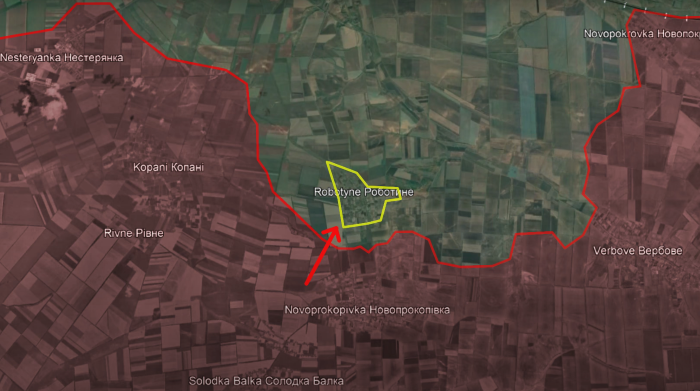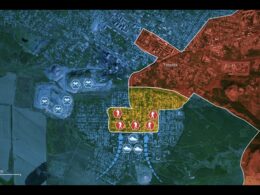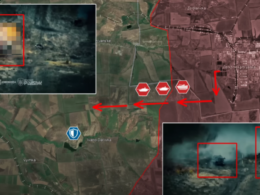Day 795: 28 April
On 28 April, there are a lot of updates from the Orikhiv direction. Here, Russian forces are continuing their offensive operation in an attempt to finally capture the village of Robotyne as a first step to eliminate the bridgehead created by Ukrainian forces in the counteroffensive last summer. To support their frontal effort, they tried to put as much pressure as possible by conducting a flank attack from the southwest of the village.

Russian forces continue to face fierce Ukrainian resistance in front of Robotyne. The main reason why they struggled to push Ukrainians out of the village with brute force was the fact that Ukrainians had spent the last month destroying enemy air defense and electronic warfare systems.
Ukrainian fighters published dozens of geolocated videos showing precise hits with HIMARS and other systems, including FPV drones, against Russian air defense systems Strila-10, TOR-M2, and BUK. Some of those attacks were coordinated and captured in real-time by the Ukrainian surveillance drone SHARK, which was created specifically to monitor and adjust fire on the battlefield.
Among the most precious targets were the Russian electronic warfare system Palantin and the radar and command center of the S-400 air defense system, both successfully destroyed by HIMARS rockets. It is worth mentioning that based solely on publicly available internet footage, Ukrainian forces managed to destroy an astonishing total of nine air defense systems and three electronic warfare systems within a short time frame in this relatively small segment of the front line in the Orikhiv direction.

This allowed Ukrainians to use drones more openly and in big volumes, which led to Russian military bloggers stating that Russian forces had decreased the tempo of their offensive operations near Robotyne exactly due to these extensive drone strikes. This put pressure on Russian commanders to overcome this localized Ukrainian air superiority.
Ukrainian sources admit that even though Russian electronic warfare is limited, it is still felt by Ukrainian drone units. However, they are adapting to this significant threat in the area by routinely switching their drones' frequencies. By doing this, even though Russians still retain some ability to control the sky, it is enough for Ukrainians to block any enemy advance in the region.
This effective use of Ukrainian FPV drones not only limited the Russian attacks with armored vehicles near Robotyne, as confirmed by many available geolocated videos of damaged vehicles in the region, but created a deadly fire pocket that prevented all frontal attacks on the village.

What effect those conditions created by the Ukrainians have on the Russian forces can be seen in the following geolocated video published by Russian military bloggers. It shows an attempt to storm the south-west part of Robotyne. A Russian infantry fighting vehicle is trying to get to the outskirts of the village to deploy infantry. It instantly comes under Ukrainian artillery and cluster munition fire even at the early stage of the attack, but even after suffering a hit, it continues to move forward.
Several surviving Russian soldiers managed to deploy in one of the first houses, where they looked for shelter to establish positions. They were quickly eliminated by the Ukrainians with the use of further artillery and FPV drones.
After many such attempts, Russians decided to put further pressure on the Ukrainian defenders in Robotyne by conducting a flank attack southwest of the village, which was again successfully rebuffed by the Ukrainians with the help of FPV drones, artillery, and mortar fire.
As a result, Ukrainian Tavriisk Group of Forces Commander Oleksandr Tarnavskyi stated that Russian forces in the Orikhiv direction are now trying to move into small infantry groups.

All attacks on the settlement yielded limited results, and there has been no Russian progress, as stated in previous days by some of the most prominent Russian analysts, who started to doubt whether prioritizing Robotyne in this direction was the right choice. Another Russian military blogger sounded the alarm by claiming that Russian forces operating in the Zaporizhzhia direction do not have enough drones and that those operating near Robotyne lack adequate counter-battery and electronic warfare capabilities.
Overall, Ukrainian forces managed to control the Russian momentum and hold the front line south of Orikhiv stable despite all enemy efforts. The situation remains difficult, as Russians do not relinquish the idea of regaining ground here.
Ukrainian Commander-in-Chief described Russian assaults near Robotyne as localized offensive operations that aim to recover previously lost territory. Ukrainian forces orchestrated numerous strikes targeting Russian air defense and electronic warfare systems to discourage them from potential attacks in this direction.
These precise maneuvers, which led to the crucial establishment of limited air superiority by Ukrainian drones, proved pivotal in countering Russian tactical approaches. Hopefully, the Ukrainian forces will soon receive the much-awaited artillery shells from their Western partners, which will help them to stabilize the front line even more and possibly even retake the initiative.
In our daily frontline report, we pair up with the military blogger Reporting from Ukraine to keep you informed about what is happening on the battlefield in the Russo-Ukrainian war.
Read also:




